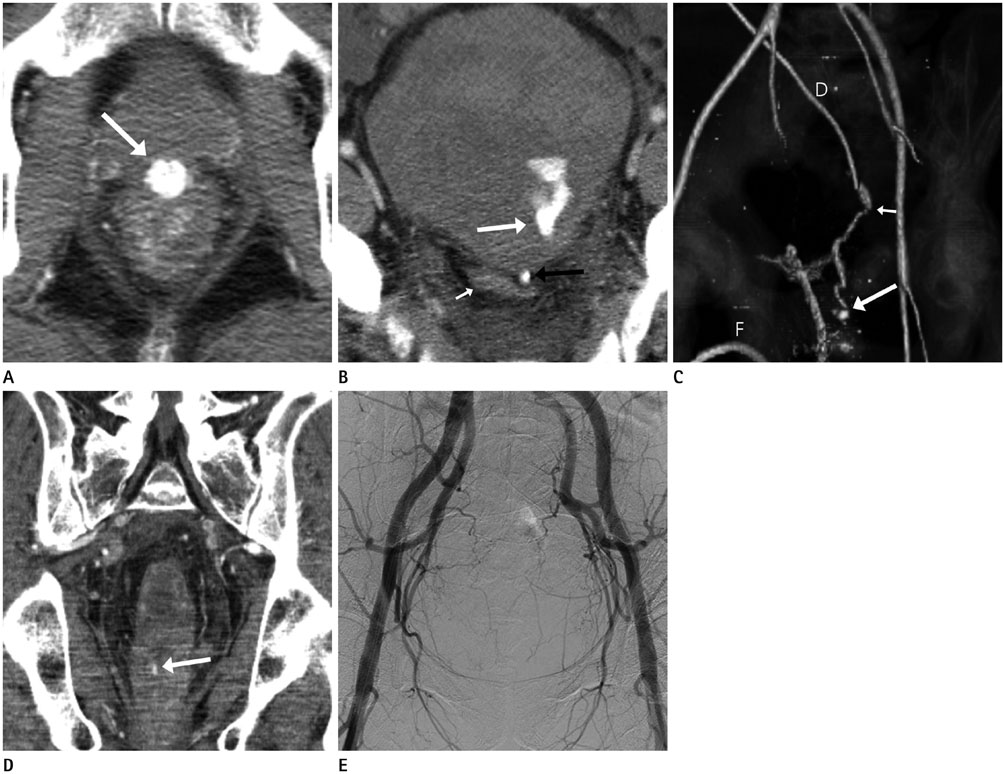J Korean Soc Radiol.
2015 Jan;72(1):29-32. 10.3348/jksr.2015.72.1.29.
Traumatic Pseudoaneurysm of the Superior Rectal Artery with Recurrent Lower Gastrointestinal and Pelvic Extraperitoneal Bleeding: Importance of Pretreatment Recognition
- Affiliations
-
- 1Department of Radiology, Ilsan Paik Hospital, Inje University College of Medicine, Goyang, Korea. seojwrad@paik.ac.kr
- KMID: 1823931
- DOI: http://doi.org/10.3348/jksr.2015.72.1.29
Abstract
- Traumatic pseudoaneurysm of the superior rectal artery is a rare cause of massive lower gastrointestinal bleeding. We reported a case of a 43-year-old male patient with pseudoaneurysm following a penetrating perineal wound. The patient had repeat massive lower gastrointestinal and pelvic extraperitoneal bleeding and was diagnosed as traumatic pseudoaneurysm of the superior rectal artery. To our knowledge, there are three case reports of traumatic pseudoaneurysm of the superior rectal artery treated by embolization. However, spontaneous regression occurred in the study subject after surgical hematoma removal, without any further pseudoaneurysm resection.
Figure
Reference
-
1. Jesinger RA, Thoreson AA, Lamba R. Abdominal and pelvic aneurysms and pseudoaneurysms: imaging review with clinical, radiologic, and treatment correlation. Radiographics. 2013; 33:E71–E96.2. Sakamoto I, Sueyoshi E, Hazama S, Makino K, Nishida A, Yamaguchi T, et al. Endovascular treatment of iliac artery aneurysms. Radiographics. 2005; 25 Suppl 1. S213–S227.3. Janmohamed A, Noronha L, Saini A, Elton C. An unusual cause of lower gastrointestinal haemorrhage. BMJ Case Rep. 2011; 2011. http://dx.doi.org/10.1136/bcr.11.2011.5102.4. Iqbal J, Kaman L, Parkash M. Traumatic pseudoaneurysm of superior rectal artery-an unusual cause of massive lower gastrointestinal bleed: a case report. Gastroenterol Res. 2011; 4:36–38.5. Zakeri N, Cheah SO. A case of massive lower gastrointestinal bleeding: superior rectal artery pseudoaneurysm. Ann Acad Med Singapore. 2012; 41:529–531.6. Gow KW, Murphy JJ 3rd, Blair GK, Stringer DA, Culham JA, Fraser GC. Splanchnic artery pseudo-aneurysms secondary to blunt abdominal trauma in children. J Pediatr Surg. 1996; 31:812–815.7. Dror S, Dani BZ, Ur M, Yoram K. Spontaneous thrombosis of a splenic pseudoaneurysm after blunt abdominal trauma. J Trauma. 2002; 53:383–385.8. Raghavan A, Wong CK, Lam A, Stockton V. Spontaneous occlusion of post-traumatic splenic pseudoaneurysm: report of two cases in children. Pediatr Radiol. 2004; 34:355–357.9. Yi IK, Miao FL, Wong J, Narasimhan KL, Lo RH, Yee L, et al. Prophylactic embolization of hepatic artery pseudoaneurysm after blunt abdominal trauma in a child. J Pediatr Surg. 2010; 45:837–839.
- Full Text Links
- Actions
-
Cited
- CITED
-
- Close
- Share
- Similar articles
-
- Delayed Gastrointestinal Bleeding from Traumatic Superior Mesenteric Artery Pseudoaneurysm
- Superior Gluteal Artery Pseudoaneurysm Caused by Pelvic C-Clamp Blind Application: A Case Report
- A Case of Non-traumatic Hemobilia due to Pseudoaneurysm of the Hepatic Artery
- Transcatheter Embolization Therapy of Massive Colonic Bleeding
- Traumatic Pseudoaneurysm of the External and Internal Carotid Artery Presenting as Epistaxis: Case Report


